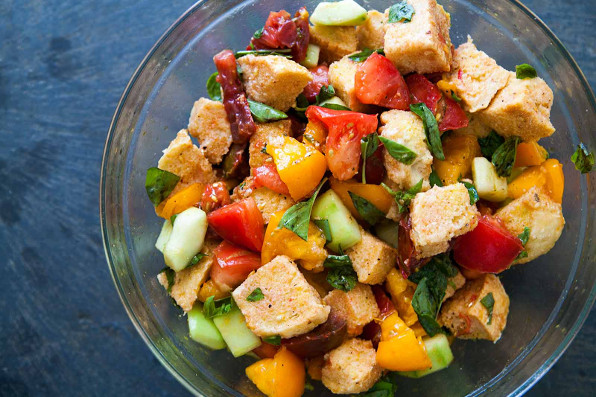It’s no secret that poor people can’t afford expensive food, and that they tend to buy cheaper (and often less nutritious) foods so they can afford enough to fill their stomachs. Now, there’s a study that proves income and education levels directly influence dietary preferences…
 Panzanella Salad: A classic Italian Salad anyone would love. Just add
Panzanella Salad: A classic Italian Salad anyone would love. Just add
Protein and make it a meal! But how do you get folks whose dietary
preferences and habits don’t include Salad to eat it,
no matter how cheap you make it?
Researchers at the University of Washington conducted a block-by-block survey of Seattle quizzing residents on their food preferences, education levels and income brackets. What they found was not totally unexpected, but disappointing, nevertheless.
What they did…
Researchers mapped dietary data from nearly 1,100 adult participants of the Seattle Obesity Study based on their home addresses, and linked them to residential property values obtained from the King County, WA, tax assessor. Information on age, gender and race/ethnicity as well as education and annual household income were gathered via telephone surveys. Participants were also asked how often they ate salad and/or drank soft drinks/soda. Healthy Eating Index scores, a measure of diet quality, were calculated for each participant. Scores ranged from 0 to 100 with higher scores indicating a better diet quality.
What they found…
Using participant-reported Soda and Salad consumption as spot indicators of poorer and better quality diets, researchers found that:
- People who ate more Salad tended to have higher Healthy Eating Index scores associated with more healthy eating behaviors. People who drank more Soda tended to have lower scores.
- While the disparities of Soda consumption by neighborhood were clear, there was no significant difference by age, income or education.
- Black and Hispanic residents reported more frequent Soda consumption than White residents.
- Women tended to eat more Salad than men, as did adults age 55 and older. (No surprise, there…)
- Adults with some college education or more consumed Salad more often every week than those with only a high school education or less.
- People earning $50,000 or more ate more Salad per week than those earning less than $50,000 annually.
- There was no significant difference in Salad consumption by race or ethnicity.
The takeaway…
“Interventions [aimed at] promoting healthier diets tend to focus on taxing Soda, which is perceived as too cheap, and reducing the price of Fresh Produce, which is perceived as too expensive,” says study’s Lead Author, Adam Drewnowski. “Initiatives to replace Soda with Salad [confront] the issue[s] of socioeconomic status and income purchasing power, and those are very complex issues.”
As more municipalities and higher-level governments seek to develop targeted interventions for better health, they will need location-based tools to identify high-risk or high-need communities, according to the study.
My take…
“…[T]axing Soda, which is perceived as too cheap, and reducing the price of Fresh Produce,” won’t do the trick.
Taxing Soda and other Sugary foods has been shown to reduce sales of these products, but the Soda and Snack makers are still thriving. Even with a 10 percent surtax, sugary Soda will continue to sell as long as it remains cheaper than Milk, Fruit Juice or other healthier beverages.
Likewise – though making healthier foods less expensive is a great and noble idea – I can’t see how governments at any level could ever make it work.
First, it would be monumentally expensive (a kinder, gentler way of saying ‘a huge additional burden on taxpayers’) if government sponsored.
Second, people wouldn’t stand for any government dictating their food preferences, no matter how cheap healthier food might become. Any such government would be voted out of office at the first opportunity – just like any government that tried to legislate lower prices for healthier foods.
And… If lower income folks aren’t used to including healthier foods in their dietary profiles, how do you get them to eat it, no matter how cheap you make them?
So, what’s a responsible, humane and innovative society to do?
Rather than concentrating on discouraging poor dietary choices and encouraging consumption of healthier foods, governments at all levels need to enable socially and financially disadvantaged people to afford better food. That’s the real challenge.
Reducing food waste and channelling perfectly good ‘surplus’ food to those who need it is just one major way we all contribute to such an effort.
~ Maggie J.

